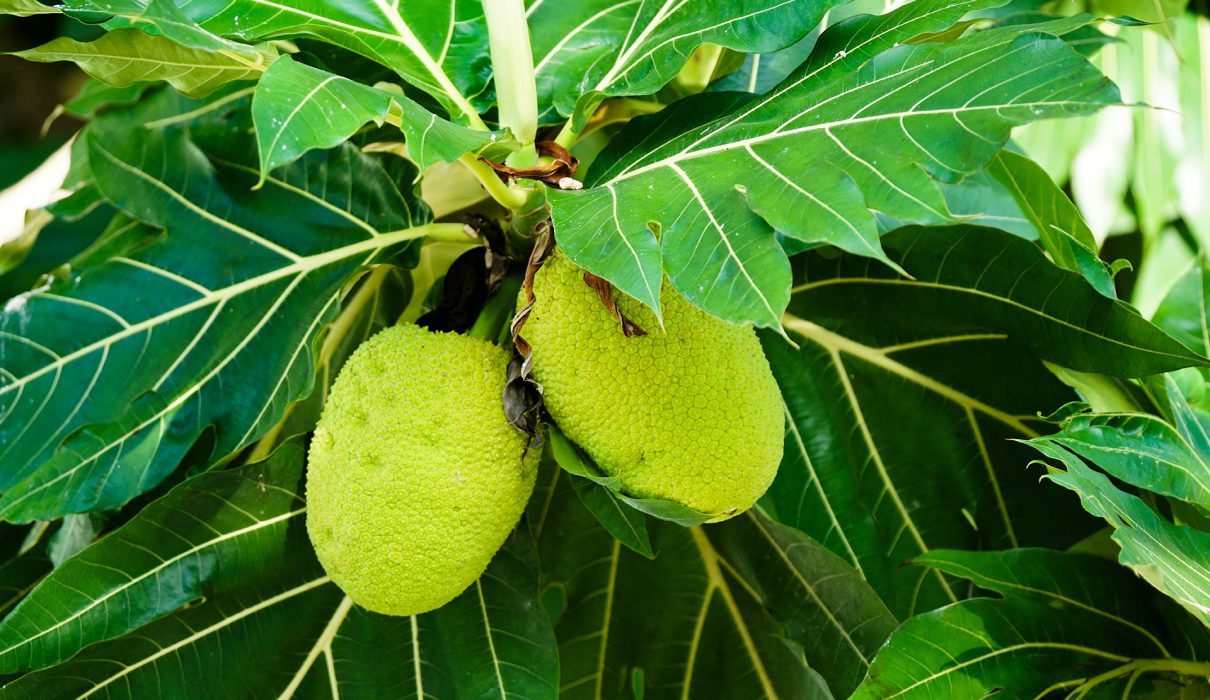The breadfruit tree is one of the largest and most significant trees in the Maldives, often found in home gardens and community spaces. These trees can grow up to 26 meters (85 feet) tall, with a broad, spreading canopy that provides shade and shelter. The large, lobed leaves and rough, knobbly fruits are distinctive features of the tree, making it easily recognizable. Breadfruit trees are often planted near homes and in communal areas, serving both practical and aesthetic purposes. Their presence enhances the tropical landscape and contributes to the biodiversity of the islands.
Breadfruit in Noonu Lhohi
In Noonu Lhohi, breadfruit trees were everywhere when I was a child. Almost every house had one. Now, there are fewer trees, but most houses still have a breadfruit tree. Our favorite snack on the island is called “theluli keyo,” which is the local name for breadfruit chips. This tasty treat is a big part of our food and traditions.
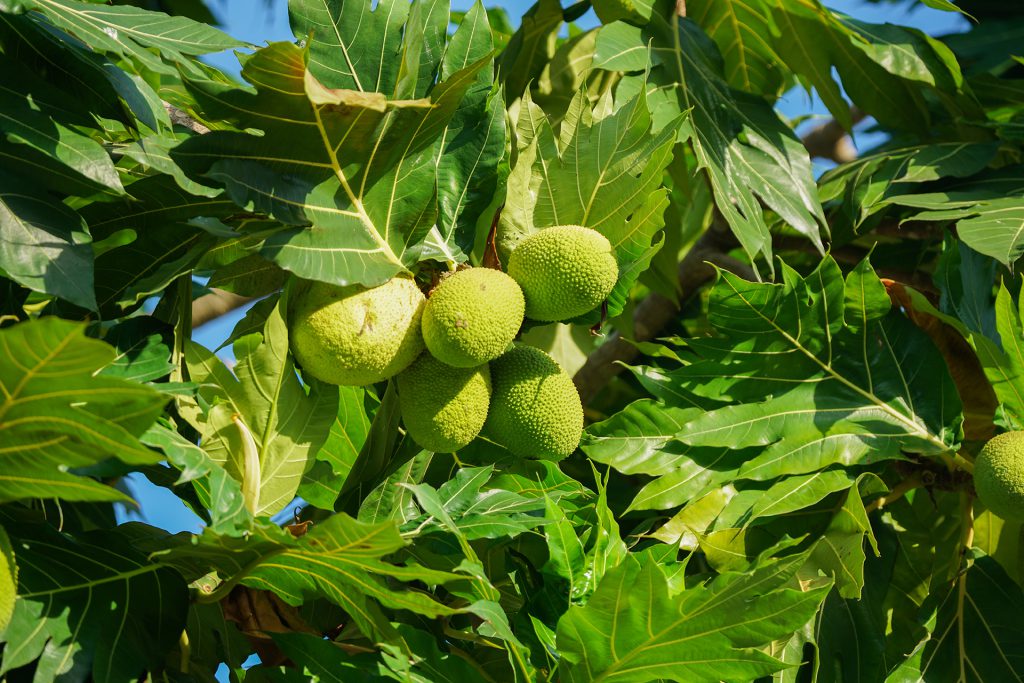
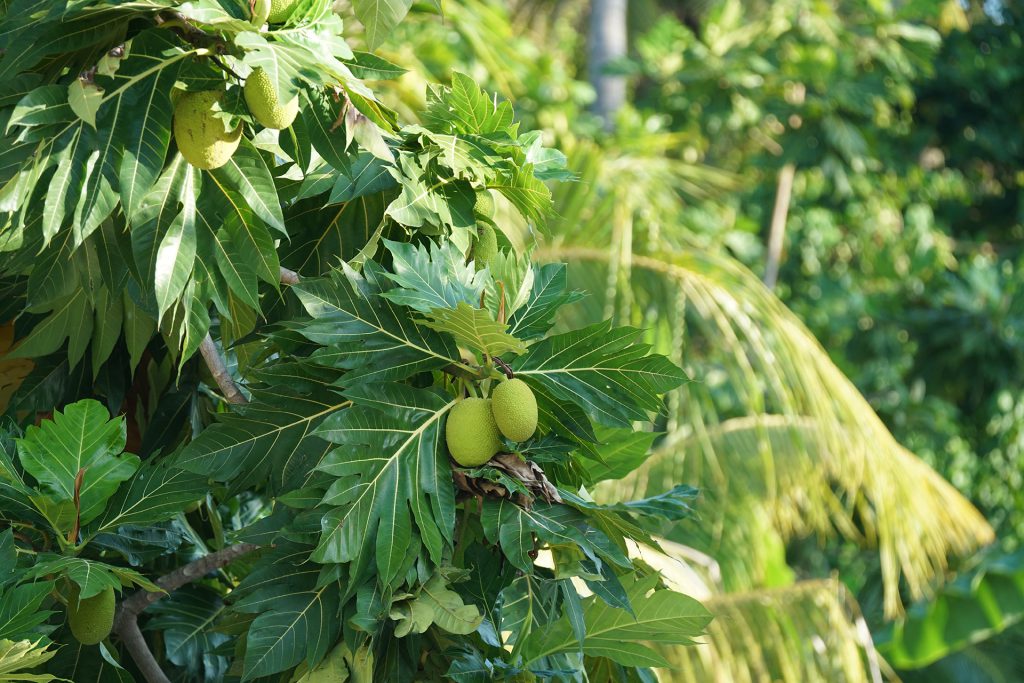
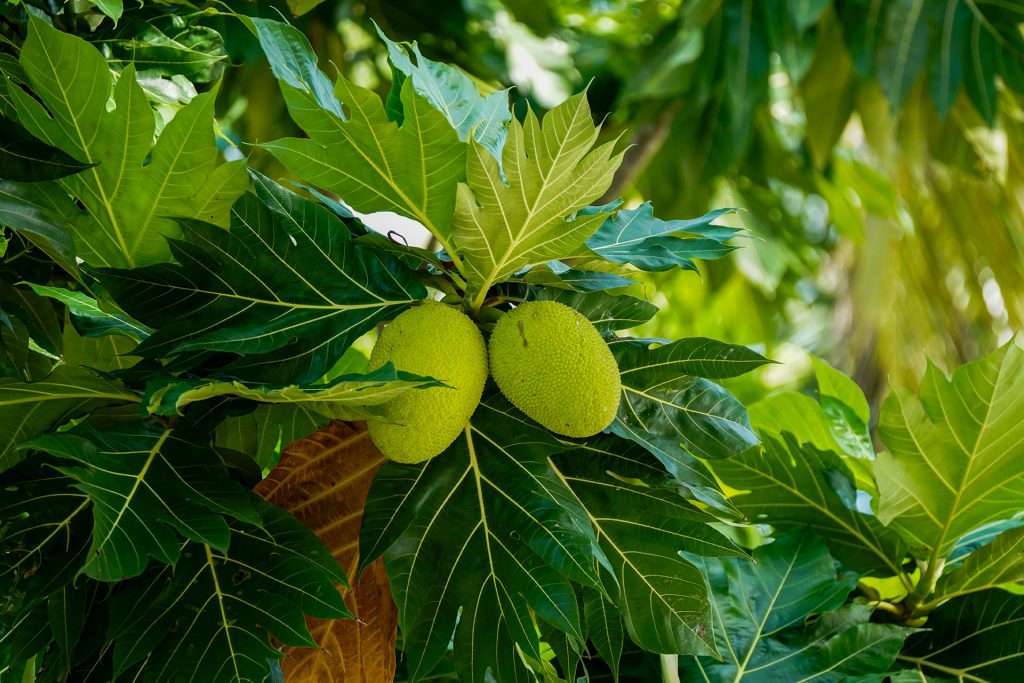
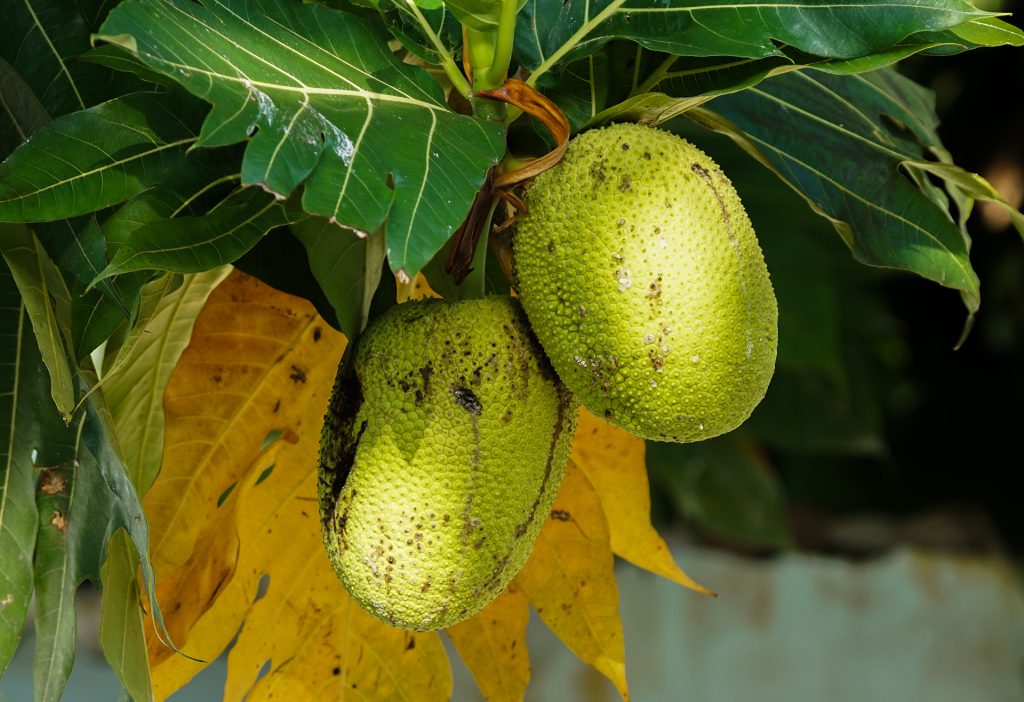
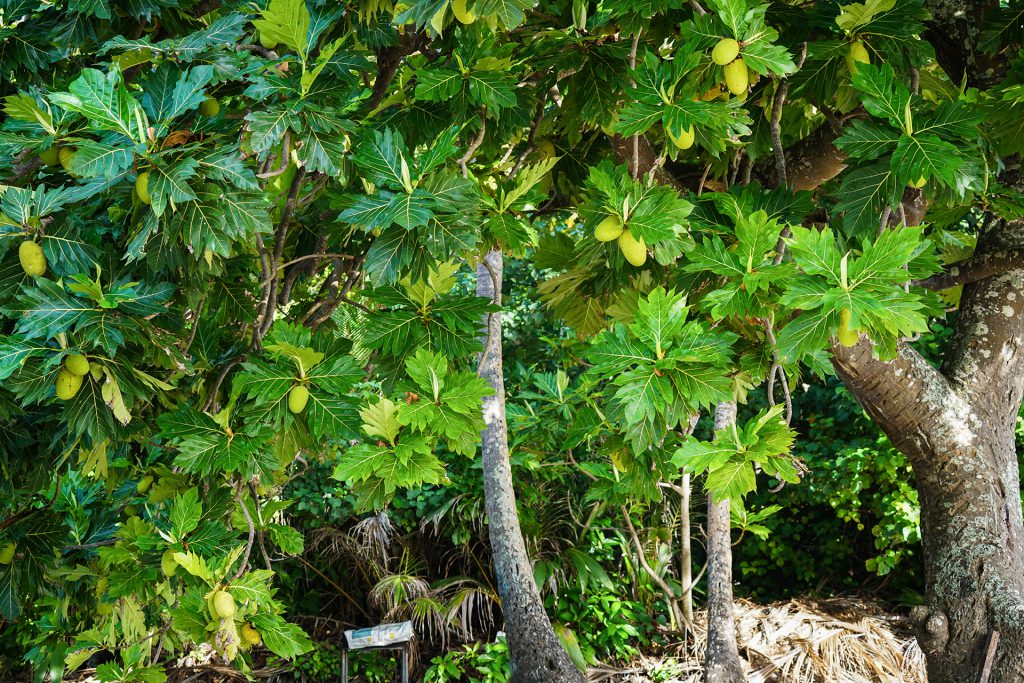
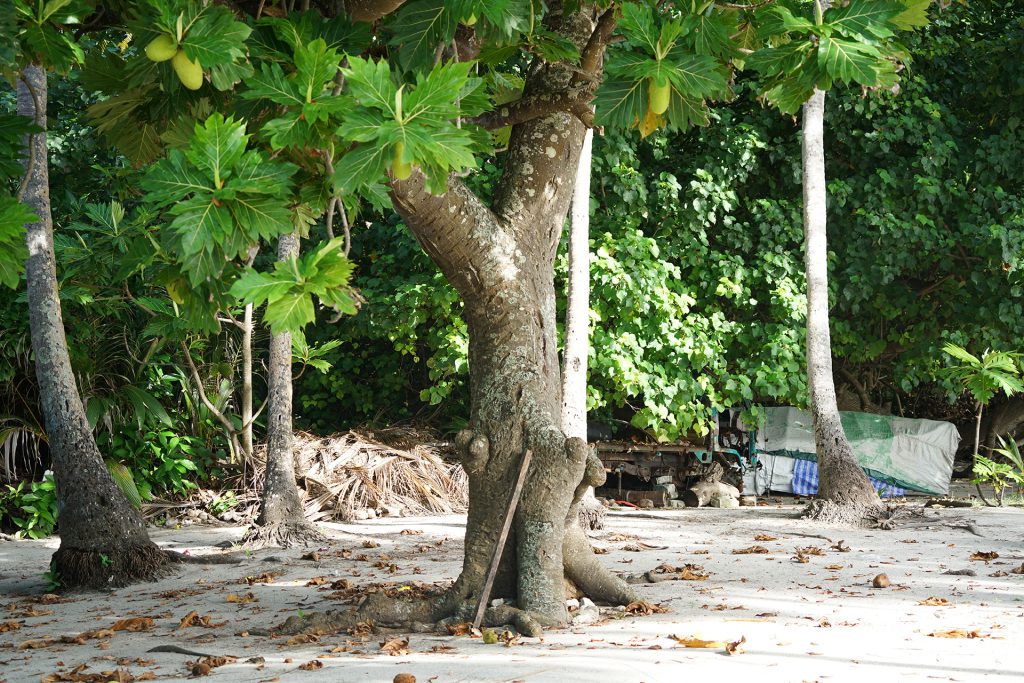
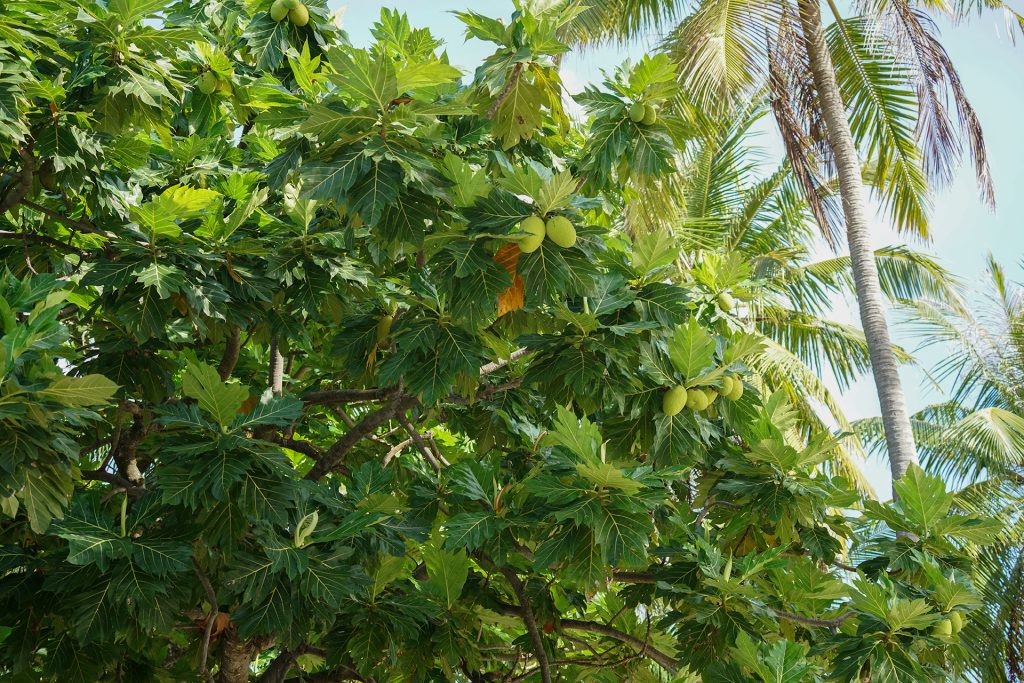
History and Origin
Breadfruit has a long history that dates back thousands of years. It is believed to have originated in the South Pacific and was spread by Polynesian voyagers across the Pacific Islands. The fruit gained international attention in the 18th century when British explorers introduced it to the Caribbean as a potential food source for enslaved Africans. This introduction was part of a broader effort to find reliable and nutritious food sources for colonial plantations.
Botanical Description
Breadfruit trees are large, evergreen, and can grow up to 26 meters (85 feet) tall. They belong to the Moraceae family, which also includes figs and mulberries. The trees have broad, lobed leaves that are glossy green and can reach up to 60 centimeters (24 inches) in length. The fruit itself is typically round, oval, or oblong, with a rough, green to yellow-brown skin. Inside, the flesh is creamy white or yellow and has a texture similar to that of a potato when cooked.
Scientific Classification
Breadfruit belongs to the Moraceae family and has the following scientific classification:
- Kingdom: Plantae
- Clade: Tracheophytes
- Clade: Angiosperms
- Clade: Eudicots
- Clade: Rosids
- Order: Rosales
- Family: Moraceae
- Genus: Artocarpus
- Species: A. altilis
- Binomial Name: Artocarpus altilis (Parkinson) Fosberg
Cultivation and Harvesting
Breadfruit trees thrive in tropical climates with well-drained soil and plenty of sunlight. They are relatively easy to grow and can produce fruit for decades, making them an excellent long-term food source. The trees can be propagated through seeds, cuttings, or root shoots. Once planted, breadfruit trees usually begin to bear fruit within three to five years.
The fruiting season varies depending on the region but typically occurs once or twice a year. Harvesting is done by hand, using poles to reach the high branches. Care must be taken to handle the fruit gently to avoid bruising and damage.
Nutritional Value and Health Benefits
Breadfruit is a highly nutritious food that offers numerous health benefits. It is rich in complex carbohydrates, dietary fiber, vitamins, and minerals. Some key nutritional components of breadfruit include:
- Carbohydrates: Breadfruit is an excellent source of energy due to its high carbohydrate content.
- Dietary Fiber: It aids in digestion and helps maintain a healthy digestive system.
- Vitamins: Breadfruit is rich in vitamin C, which supports the immune system, and vitamin B6, which is important for brain health.
- Minerals: It provides essential minerals such as potassium, which helps regulate blood pressure, and magnesium, which is important for muscle and nerve function.
Consuming breadfruit can help boost energy levels, support immune function, and promote overall health. Its high fiber content also makes it beneficial for maintaining a healthy digestive system.
Culinary Uses
Breadfruit is incredibly versatile in the kitchen and can be prepared in various ways. It can be boiled, roasted, baked, fried, or even mashed. Its starchy texture allows it to be used as a substitute for potatoes or other root vegetables in many recipes.
Breadfruit in Maldivian Cuisine
Breadfruit, known locally as “Banbukeyo,” holds a special place in Maldivian culture and cuisine. The breadfruit tree is one of the largest and most significant trees in the Maldives, often found in home gardens and community spaces. The tree’s presence is not just a source of food but also a symbol of prosperity and sustenance, reflecting the deep connection Maldivians have with their natural environment.
Childhood Memories
For many Maldivians, breadfruit is more than just a food source; it is a cherished part of their childhood. The experience of climbing a breadfruit tree to pick the ripe fruits, helping to peel and slice the breadfruit, and eagerly waiting for the freshly fried chips to cool down are fond memories shared across generations. Breadfruit chips were a common snack found in the pockets of children, enjoyed during school breaks, family gatherings, and community events. These memories are an integral part of Maldivian heritage, symbolizing the simplicity and joy of island life.
Culinary Uses in Maldivian Cuisine
Breadfruit is a versatile ingredient in Maldivian cuisine, used in various traditional dishes that highlight its unique texture and flavor. The most beloved form of breadfruit is the breadfruit chips, a crunchy and delicious snack that is deeply rooted in Maldivian food culture.
Breadfruit Chips
Breadfruit chips are the most favorite snack in the Maldives, enjoyed by people of all ages. They are made from fully grown, green-skinned breadfruits with brown spots, ensuring they are fresh and not overly ripe. The preparation of breadfruit chips involves peeling the fruit, slicing it into thin wedges, soaking the slices to remove any residual gum, and frying them until golden brown. The result is a crispy, savory snack that retains the natural taste of breadfruit and can be stored for many days.
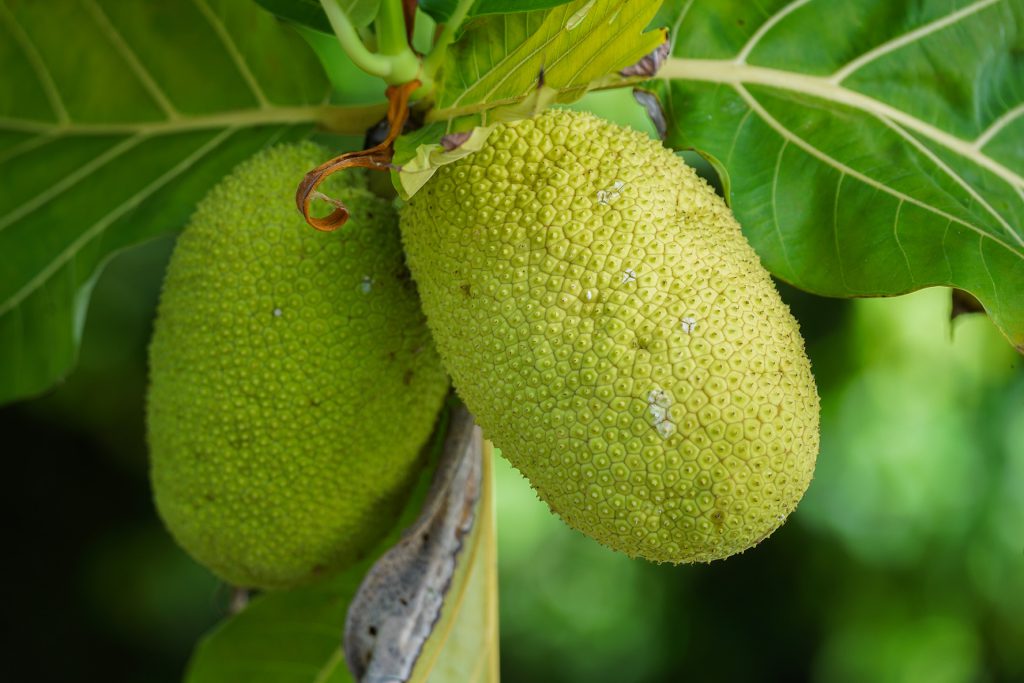
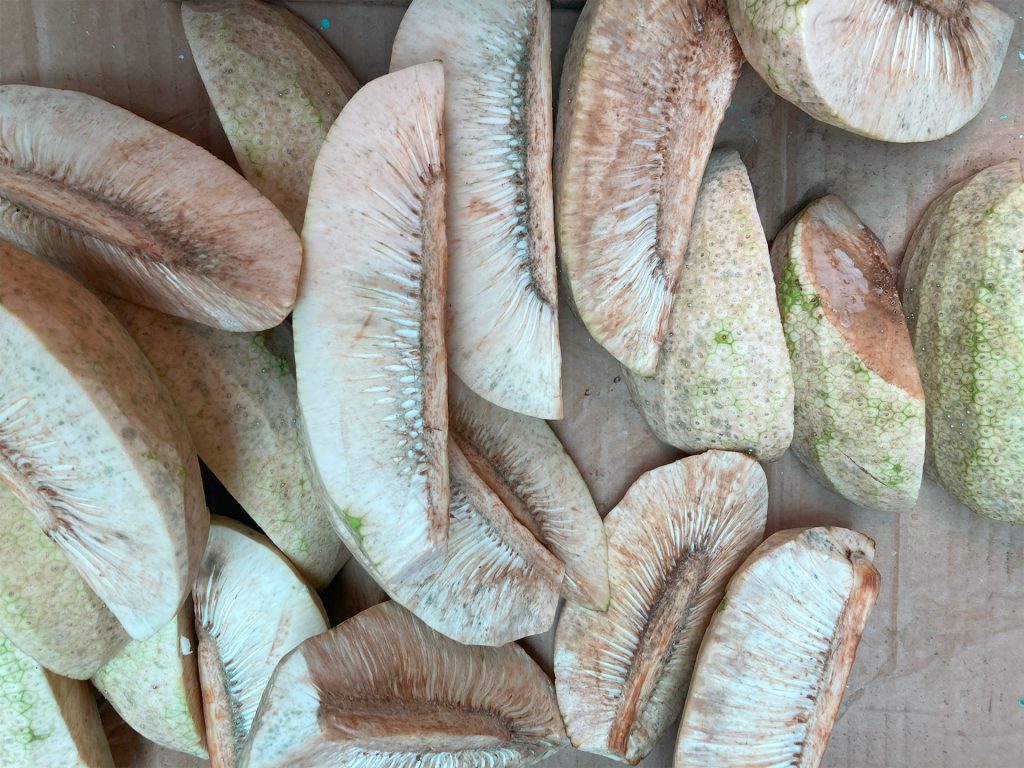
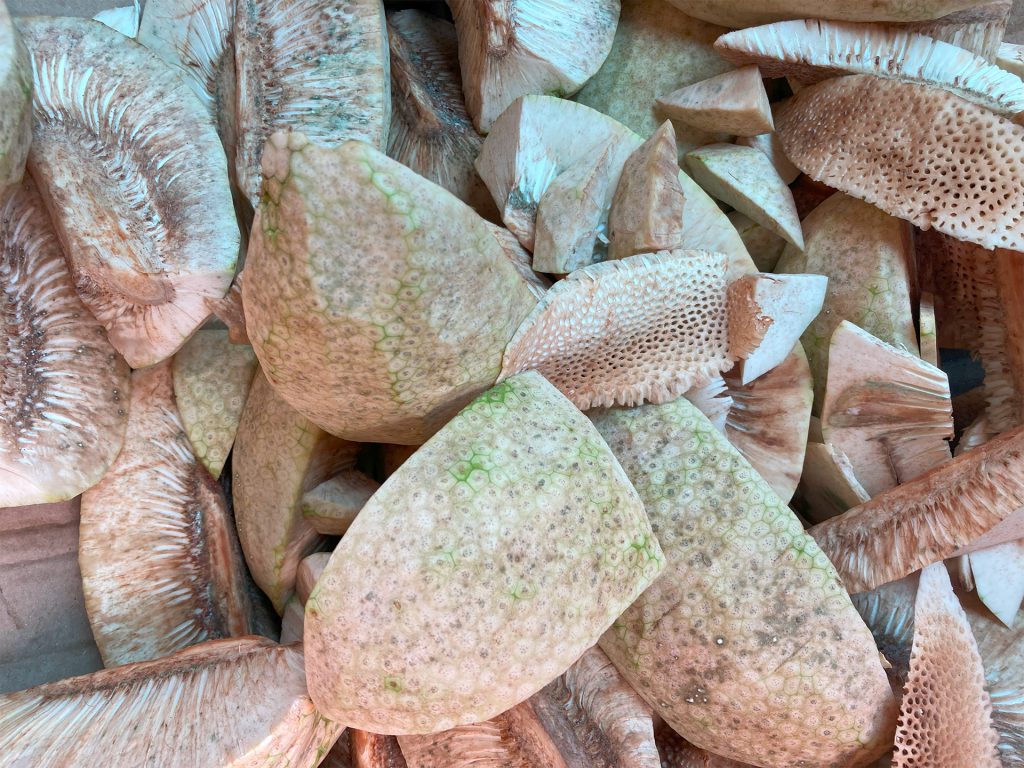
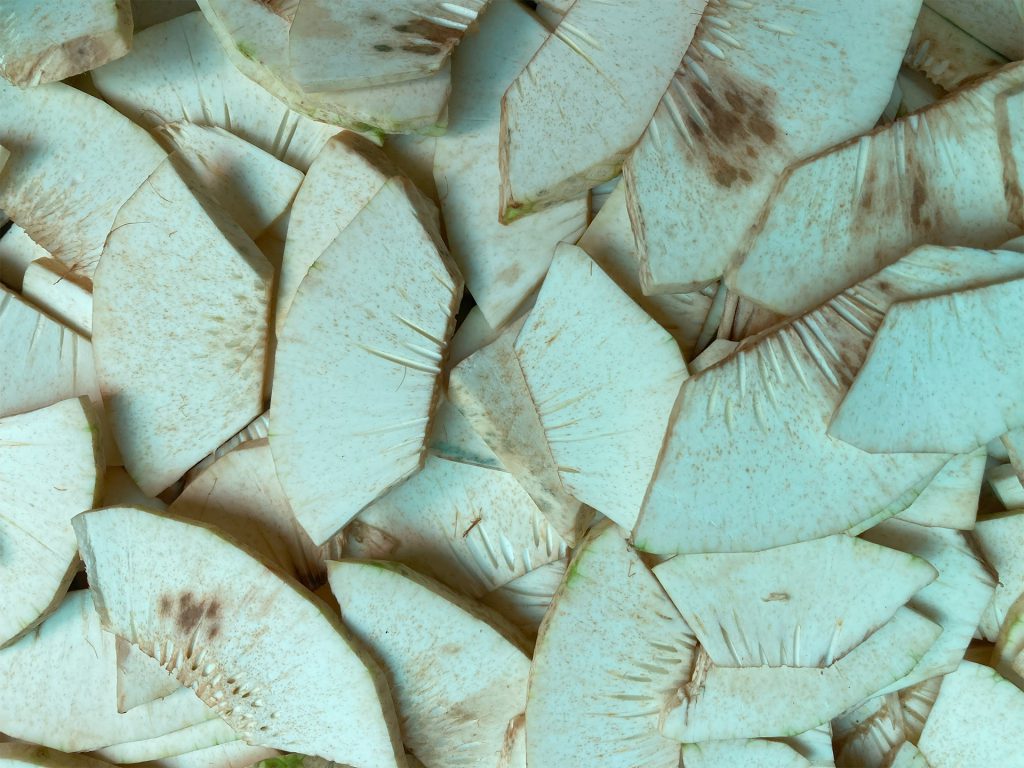
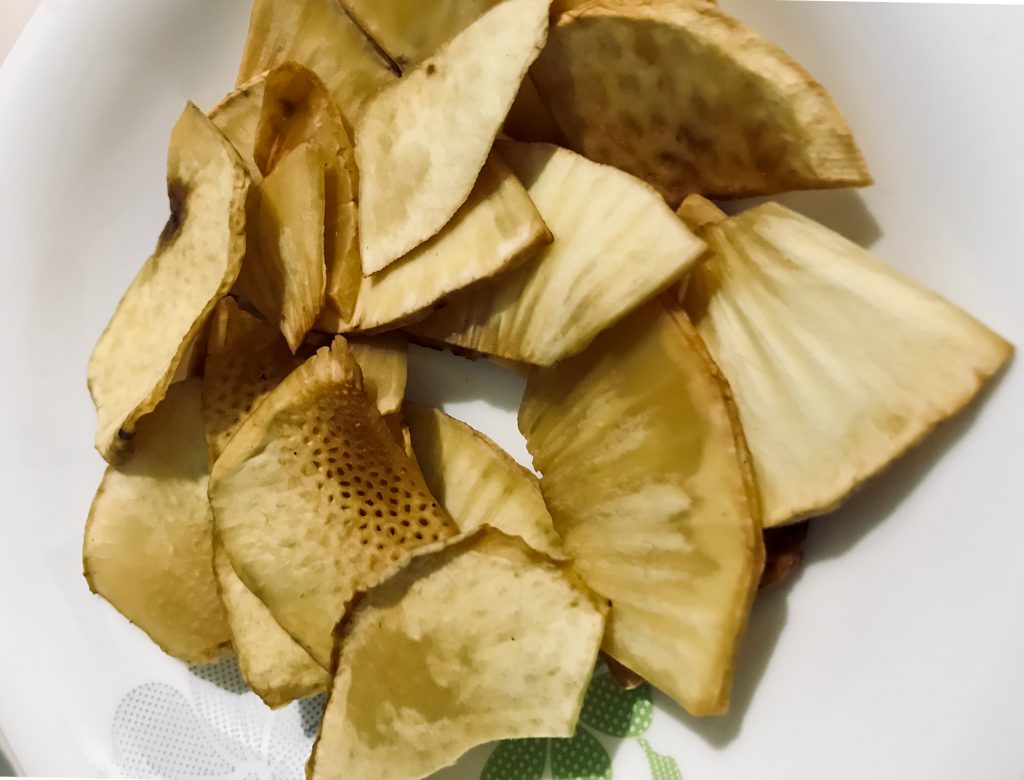
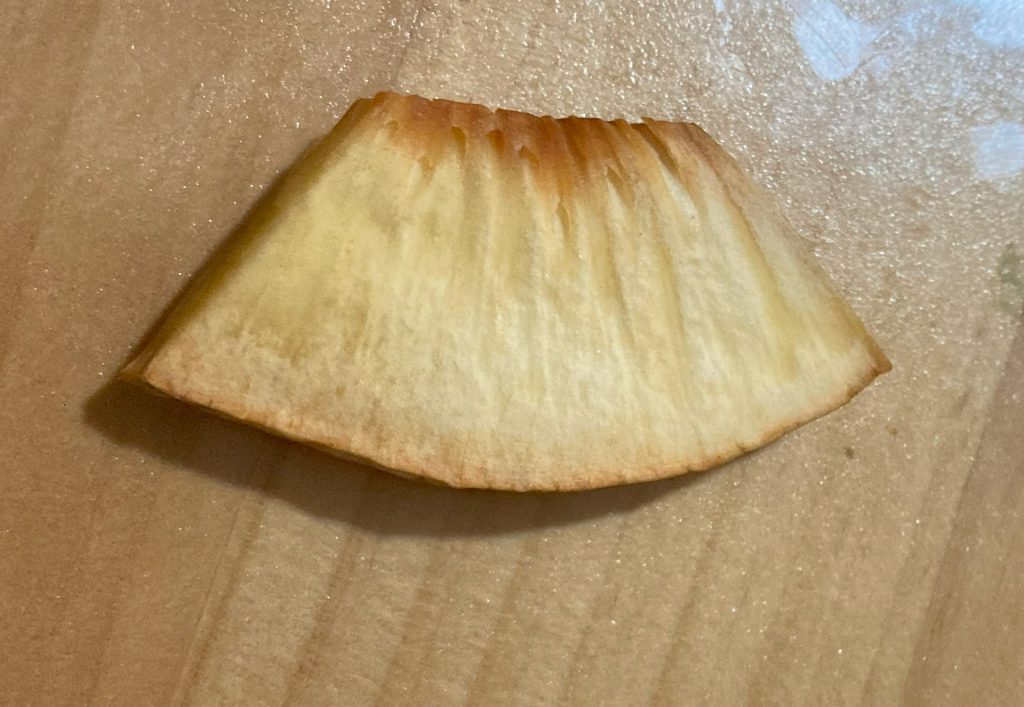
Ingredients:
- Breadfruit
- Oil (vegetable or coconut oil)
Method:
- Preparation:
- Peel the breadfruit, taking care to remove the sticky sap by applying oil to the knife or heating it over a flame.
- Cut the peeled fruit into thin wedges or slices, about 10 to 15 millimeters thick.
- Soaking:
- Immerse the slices in water for 10 minutes to remove any residual gum. Drain thoroughly.
- Frying:
- Heat oil in a deep frying pan to 180°C (350°F). Fry the slices in small batches, avoiding overcrowding the pan.
- Fry until golden brown, about 5 to 7 minutes. Drain on paper towels.
Tips:
- Ensure the oil is at the correct temperature to prevent the chips from becoming greasy.
These breadfruit chips are a delightful alternative to commercial potato chips, offering a unique and natural taste. They can be enjoyed as a crunchy snack any time of the day.
Other Traditional Breadfruit Dishes
- Boakuri Bambukeyo (Candied Breadfruit): This sweet treat is made from fresh or sun-dried breadfruit cooked with sugar. The breadfruit pieces are caramelized, creating a delicious, sticky confection that is a popular dessert in the Maldives.
- Banbukeyo Bondibai (Breadfruit Dessert): This traditional dessert involves boiling breadfruit until tender, draining and rinsing it, then mixing with sugar and simmering with coconut cream. The resulting dish is sweet, creamy, and rich, making it a favorite among locals.
- Breadfruit Curry: A savory dish where breadfruit is cooked in a spiced curry with coconut milk. The natural sweetness of the breadfruit complements the spices, creating a flavorful and hearty meal.
- Breadfruit Rice: Breadfruit is combined with rice and spices to create a unique and delicious meal. This dish is often served as a main course and is cherished for its comforting taste and texture.
Environmental and Economic Importance
Breadfruit trees are not only valuable for their fruits but also for their environmental and economic contributions. They help maintain soil health and prevent erosion, particularly in coastal areas where they are commonly found. The trees also provide shade and habitat for various wildlife, contributing to the overall biodiversity of the islands.
Economically, breadfruit is an important crop for many Maldivian households. It is a sustainable food source that can be harvested multiple times a year, providing a steady supply of food and income. The versatility of breadfruit in culinary applications also makes it a valuable product in local markets.
Nutritional Value and Health Benefits
Breadfruit is a highly nutritious food that offers numerous health benefits. It is rich in complex carbohydrates, dietary fiber, vitamins, and minerals. Some key nutritional components of breadfruit include:
- Carbohydrates: Breadfruit is an excellent source of energy due to its high carbohydrate content.
- Dietary Fiber: It aids in digestion and helps maintain a healthy digestive system.
- Vitamins: Breadfruit is rich in vitamin C, which supports the immune system, and vitamin B6, which is important for brain health.
- Minerals: It provides essential minerals such as potassium, which helps regulate blood pressure, and magnesium, which is important for muscle and nerve function.
Consuming breadfruit can help boost energy levels, support immune function, and promote overall health. Its high fiber content also makes it beneficial for maintaining a healthy digestive system.
Conclusion
Breadfruit is an integral part of Maldivian culture, cuisine, and childhood memories. Its presence in home gardens and community spaces, along with its versatility in traditional dishes, highlights its significance in daily life. The environmental benefits of breadfruit trees and their economic importance further underscore their value to the Maldives. As a sustainable and nutritious food source, breadfruit continues to play a vital role in the health and well-being of Maldivian communities.


